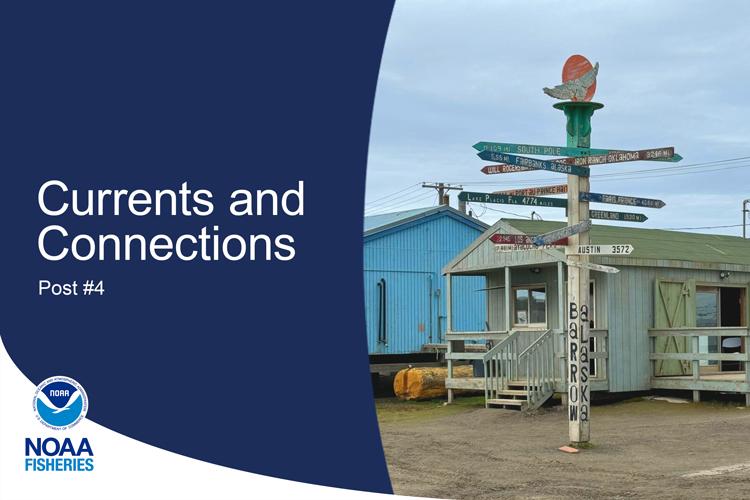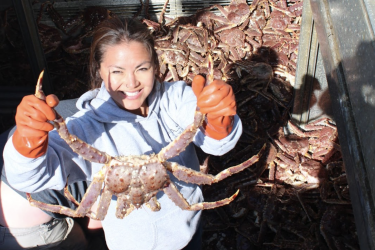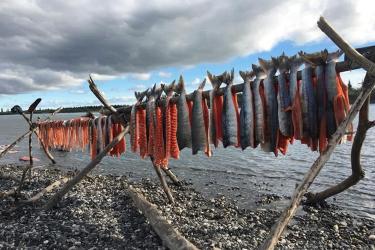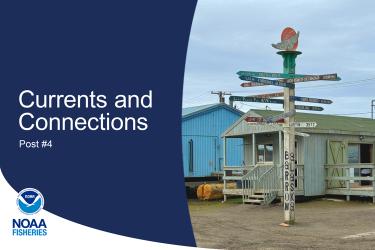Before getting too far into 2025, I wanted to highlight a few events our education team participated in during 2024. The past year was a whirlwind of travel, educational events, classroom visits, and working with summer interns. Upon reflection, it feels a little like the signpost in the picture above — moving in all directions. However, we really were strategic in our efforts to build stronger relationships with communities, support science, technology, engineering, art, and math (STEAM) opportunities and engage students, teachers and community members in our science.
I’ll start with the Barrow Arctic Research Center (BARC) Science and Culture Fair.
BARC Science and Culture Fair
I traveled with Mabel Baldwin-Schaeffer, Alaska Fisheries Science Center’s Tribal Research Coordinator, to Utqiaġvik during August to participate in the 2024 Barrow Arctic Research Center (BARC) Science and Culture Fair. The Barrow Arctic Research Center and Barrow Environmental Observatory are managed by UIC Science, a business unit of the Ukpeaġvik Iñupiat Corporation. The BARC Science Fair is a summer STEAM event for visiting scientists and educators to take part in activities with students and the community.
Each of the five days included afternoon youth activities, a community “BARC-B’que”, and evening science presentations. Local, national, and international research institutions engaged with hundreds of local students and residents. The purpose of the BARC Science Fair is to provide a positive space for Arctic researchers and Arctic residents to meet, eat with each other, spend time, and share ideas; and to inspire the youth of the Arctic by providing fun and educational activities that are based in western science and Indigenous Knowledge.
Who’s Calling Underwater?
The first activity we led was entitled: “Who's Calling Underwater? Studying Marine Mammals by their voices.” This activity is a direct application of the passive acoustic techniques used by scientists at the Alaska Fisheries Science Center to monitor Alaskan waters for marine mammals and the natural and man-made sounds present in their habitats. It is a hands-on way for students to understand the sounds, process, and the importance of sound in marine mammal research.
Marine Mammal Laboratory scientists listen for eleven different species of marine mammals including bowhead, gray, North Pacific right, humpback, minke, walrus, beluga, and killer whales; ribbon and bearded seals; and walrus. They also track and analyze environmental and man-made noises from sources like ice, vessels, and seismic airguns.
The data collected by the Marine Mammal Laboratory provides a long-term record (since 2007) of marine mammal presence and the environmental sounds around them. This is especially important in the context of a changing marine environment in the region.
How Do We Find Seals on Ice?
The second activity we led was entitled: “How Do We Find Seals on Ice?” Students learned how Alaska Fisheries Science Center scientists use cameras to help survey animals on ice and how thermal cameras can be used to find animals among thousands of photographs.
Four species of ice-associated seals, bearded seals, ringed seals, spotted seals, and ribbon seals, inhabit the Bering, Chukchi, and Beaufort seas of the Alaskan Arctic. Collectively, they are often referred to as “ice seals”. These seals are key ecological components of arctic marine ecosystems and are vital resources for Alaska Native communities, providing food and supporting their traditional way of life.
Scientists use aerial surveys to count and map the locations of the different species of ice seals, which is important for complying with federal law and our responsibilities under Alaska co-management agreements with Alaska Indigenous communities and Tribes. Co-management agreements with Alaska Indigenous communities and Tribes are formal agreements that share management responsibilities between the federal government and Tribes. The Ice Seal Committee and NOAA Fisheries work together to 1) promote the sustained health of Alaskan Ice Seals in order to protect the culture and way of life of Alaska Natives who rely on the harvest of ice seals for subsistence uses; 2) advance co-management, research, and the use of traditional knowledge of Alaska Natives; and 3) provide information to subsistence hunters and the public at large.
NOAA Scientists outfit NOAA Twin Otter planes with pairs of cameras, regular and advanced thermal (infrared) imaging, which take thousands of images. Seals can be hard to spot on a vast ice field, but their warm bodies glow brightly against the cold sea ice when viewed in infrared. Our scientists then analyze the images to count seals and learn where the different seal species live.
Sparking Curiosity
The BARC Science and Culture Fair was an incredible opportunity to engage youth in hands-on and place-based activities. These activities foster a sense of curiosity, creativity, and a connection to community even in the youngest students. Curiosity can help youth embrace the journey of discovery, find joy in the unknown, and turn challenges into opportunities. The Alaska Fisheries Science Center’s education team encourages youth to explore the world around them by making science accessible and connecting it to the world they see daily in the hopes that we might inspire a few future scientists.
Stay tuned for additional year-in-review posts highlighting our 2024 education programs and accomplishments. We also will host guest blog posts from the inaugural cohort of teachers who participated in the NOAA Teachers in the Field program and from our current science education and communication interns.











